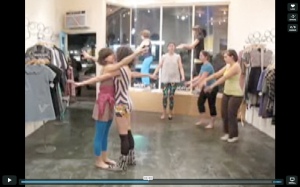“Dancing Daze: bodycity gets its groove on,” Artillery Magazine. Vol. 3 Issue 1, Sept. / Oct. 2008, p 21-22.
“Dancing Daze: bodycity gets its groove on,” Artillery Magazine. Vol. 3 Issue 1, Sept. / Oct. 2008, p 21-22.
After being thoroughly hijacked by fundamentalists, and injected into bombs and body bags in distant lands, the term “democracy” has sustained a thorough linguistic beating over the years. Despite the grim state of things today, there is hope for those who seek avenues for true emancipatory group participation. For these people it’s refreshing to see artists, especially collectives, reclaiming democracy as a working practice, a way to describe how they make their art. One such group is a hometown dance collective called bodycity.
A self-proclaimed “dance democracy”, bodycity, previously known as collective static, has performed in both public and private spaces in and around Los Angeles for the past three years. Composed almost entirely of women, the group’s numbers have swelled to over a dozen and waned to just five as members have come and gone. Only a few ever took classical ballet or modern dance and most get their prior training from rocking out alone at home. Collectively their dance philosophy eschews any conservative ideology demanding choreographic or physical perfection. Instead, their practice bristles with a do-it-yourself spirit based in accepting imperfections, embracing mistakes as opportunities, assets that heighten the possibility of democratic inclusiveness.
The troupe’s aesthetic is part Barbara Mettler, with her totally improvisational dance philosophy (which got rid of the stage, and the audience, all together), and part Judson Dance Theater, which revolutionized the professional dance world by creating performances emphasizing chance and repetitive movement. In line with this tradition, bodycity’s choreography is full of awkward repetitive actions, developed through a process of improvisation, individual and group research, and collective decision-making. Yet while they acknowledge that dance has a living history, they get more inspiration from 80’s workout videos, urban vistas, Youtube and dressage than from their modernist predecessors.
Often sewing their own costumes or enlisting friends’ creative skills, they have danced as birds to lead flocks of people along the Santa Clara River in Valencia, donned utility gloves to dance/scale the steepest street in California, performed with cacti and bamboo in the Huntington Gardens, and initiated impromptu performances in Echo Park. In costumes or not, Bodycity’s work is at its best when employing considered site specificity to bring out unexpected meaning in curious locations.
Earlier this year the dancers began collaborating with the musical group Glasser (which sounds like the Kate Bush and The Yeah Yeah Yeahs’ irrepressible lovechild) to create Lady Stranger. Performed at Mr. T’s Bowl, a hipster/hobo watering hole in Highland Park, Lady Stranger seized the venue as the perfect site to excavate latent sexual innuendo. At the start of the dance the performers, decked out in pencil skirts, tight shirts and old-fashioned lace dickies shimmy on top of booths and do-wop next to the juke box, their actions conjuring “loose women” archetypes from the 40’s and 50’s. Later the troupe erupts into fist-pounding stomps, guttural grunts, and arrow-hurling warrior poses executed with hair-raising synchronicity. These sex pot / Amazonian juxtapositions, slyly communicate how barroom interactions are themselves coded dances walking the line between fighting and fornication.
For Wikidance, created in 2007, the group capitalized on our web 2.0 obsessed culture and used the internet as a democratizing tool and a site unto itself. To initiate the piece, bodycity posted a video on vimeo.com as part of Ultimate Blogger 3, an internet blogging contest (which they almost won), asking viewers to record any movement or small dance and submit it to be incorporated as part of a final piece uniting all the submissions into one performance. The almost two-dozen submissions ranged from the bootyshakin’ to the absurdly minimalist: a man slowly leans a against a pole, a girl gyrates a’la The Village People, a couple awkwardly mock an embrace, a mother and son lock hands and gesture tai-chi-style to the camera. Yet despite the unpredictability of the submissions and the systematic structure required to put the entire piece together, the resulting performance isn’t overly cerebral or confusing; like the best user-generated internet content, it’s perfectly imperfect, addictive, inspiring, and fun to watch.
When viewed in its intended environment – on the internet – the final Wikidance is as a moving collage; the dancers promenade, pose, vogue, spin and wave, duplicating the movements in the submission videos to Yeah by LCD Soundsystem. In a brief segment two dancers, outstretched arms scissor-like, embrace one another, mimicking a particular submission video. A second later actual scissors enter the camera frame, like an animator’s eraser in a Bugs Bunny cartoon, to slice out each dancer from the video one-by-one. In de-centering choreographer’s stereotypically dictatorial position and turning the building blocks of the performance over to the very audience the dance addresses, Wikkidance proves itself quite liberating and inspiring. And that’s the key to bodycity’s allure.
Their democratic idealism requires that they practice what they preach and work with conceptual and physical exertion bordering on exaltation to bring the viewer into their dances as much as possible. When successful, their work breaks down the boundaries between dancer and audience, choreographer and company, public and private to sincerely state that dance is everywhere and that it can happen with and to anyone at any time.
Bodycity is currently: Madeline Baugh, Betsy Hume, Jennifer Lehman, Cristina Paul, Molly Rodgveller, Lake Sharp and Meagan Yellott
©2024 Tucker Neel. All rights reserved.


